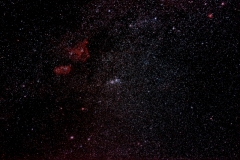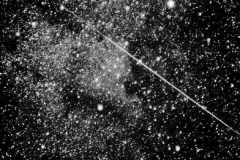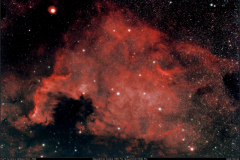[et_pb_section fb_built="1" _builder_version="3.22"][et_pb_row _builder_version="3.25" background_size="initial" background_position="top_left" background_repeat="repeat"][et_pb_column type="4_4" _builder_version="3.25" custom_padding="|||" custom_padding__hover="|||"][et_pb_text admin_label="intro Text" _builder_version="3.27.4"]
The North America Nebula covers an area of more than four times the size of the full moon, but its surface brightness is low so normally it cannot be seen with the unaided eye.
Binoculars and telescopes with large fields of view (approximately 3°) will show it as a foggy patch of light under sufficiently dark skies.
However, using a UHC filter which filters out some unwanted wavelengths of light, it can be seen by the naked eye under dark skies. Its prominent shape and especially its reddish colour (from the hydrogen Hα emission line) only show up in photographs of the area.
[/et_pb_text][/et_pb_column][/et_pb_row][et_pb_row _builder_version="3.25" background_size="initial" background_position="top_left" background_repeat="repeat" column_structure="1_4,3_4"][et_pb_column type="1_4" _builder_version="3.25" custom_padding="|||" custom_padding__hover="|||"][et_pb_text admin_label="SD Image" _builder_version="3.27.4"]
[/et_pb_text][/et_pb_column][et_pb_column type="3_4" _builder_version="3.25" custom_padding="|||" custom_padding__hover="|||"][et_pb_text admin_label="Simon Dawes Text" _builder_version="3.27.4"]
Image of the Double Cluster and North American Nebula taken from Kelling Heath by Simon Dawes, with a Canon 600D, Modified with the Full Spectrum Mod and a Clip-in CLSCCD filter
[/et_pb_text][/et_pb_column][/et_pb_row][et_pb_row _builder_version="3.25" background_size="initial" background_position="top_left" background_repeat="repeat" column_structure="1_4,3_4"][et_pb_column type="1_4" _builder_version="3.25" custom_padding="|||" custom_padding__hover="|||"][et_pb_text admin_label="AW Image" _builder_version="3.27.4"]
[/et_pb_text][/et_pb_column][et_pb_column type="3_4" _builder_version="3.25" custom_padding="|||" custom_padding__hover="|||"][et_pb_text admin_label="Andy Wilson Text" _builder_version="3.27.4"]
Imaged by: Andy Wilson
Method:LX200 8" MX916CCD
[/et_pb_text][/et_pb_column][/et_pb_row][et_pb_row _builder_version="3.25" background_size="initial" background_position="top_left" background_repeat="repeat" column_structure="1_4,3_4"][et_pb_column type="1_4" _builder_version="3.25" custom_padding="|||" custom_padding__hover="|||"][et_pb_text admin_label="JT Image" _builder_version="3.27.4"]
[/et_pb_text][/et_pb_column][et_pb_column type="3_4" _builder_version="3.25" custom_padding="|||" custom_padding__hover="|||"][et_pb_text admin_label="Julian Tworek Text" _builder_version="3.27.4"]
Imaged by: Julian Tworek
Method: Canon 100 - 400 Lens @ 200mm, ISO 800, 22 x 120s exposures on Modified Canon 20D and AstroTrac
Taken from Kelling Heath Star Party
[/et_pb_text][/et_pb_column][/et_pb_row][et_pb_row _builder_version="4.7.4" _module_preset="default" column_structure="1_4,3_4"][et_pb_column _builder_version="4.7.4" _module_preset="default" type="1_4"][et_pb_text _builder_version="4.7.4" _module_preset="default" admin_label="LS Image" hover_enabled="0" sticky_enabled="0"]
[/et_pb_text][/et_pb_column][et_pb_column _builder_version="4.7.4" _module_preset="default" type="3_4"][et_pb_text _builder_version="4.7.4" _module_preset="default" hover_enabled="0" sticky_enabled="0"]
Image by Leigh Slomer NGC 7000, Sharpless 117, Caldwell 20 The North America Nebula. An emission nebula located close to Deneb in the constellation of Cygnus. My 1st serious attempt at an astro image. Taken from images captured over 3 nights in late September and early October, it was my 1st image to go more than a few minutes over 1 hour in total exposure time and the 1st to incorporate proper calibration frames.
[/et_pb_text][/et_pb_column][/et_pb_row][/et_pb_section]




